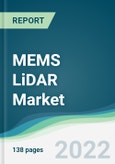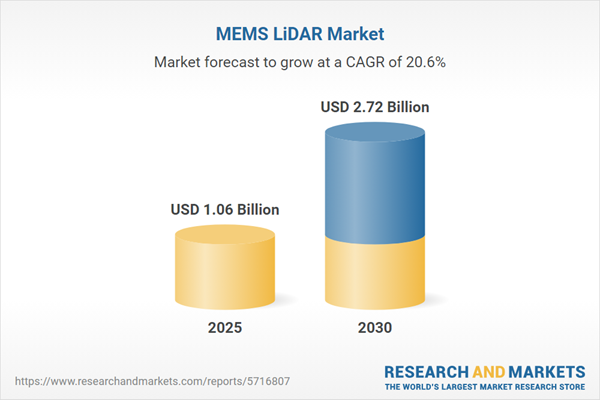The MEMS LiDAR market is poised for steady growth, driven by its compact size, high speed, and cost-effectiveness compared to other laser scanners. MEMS mirror-based LiDAR systems are evaluated using a figure of merit based on aperture size, field of view, and resonant frequency, highlighting their suitability for diverse applications, particularly in automotive and space sectors.
Market Drivers
Automotive Sector Demand
The automotive industry is a key growth driver for the MEMS LiDAR market, fueled by the rising demand for autonomous vehicles. MEMS technology enables the production of compact, affordable LiDAR sensors, which are increasingly integrated by major manufacturers like BMW and Volvo to enhance driving safety. Technological advancements, including adaptive algorithms, high-definition mapping, and improved sensor processing, have spurred the production of autonomous vehicles reliant on LiDAR. For example, RoboSense’s RS-LiDAR-M1, a MEMS solid-state LiDAR, adheres to rigorous standards like VDA6.3, IATF16949, ISO26262, and ISO16750, ensuring reliability in varied weather conditions for intelligent vehicles.Product innovations further accelerate market growth. In 2023, Mercedes Benz’s Drive Pilot technology, certified for Level 3 autonomous driving, enables vehicles to handle driving tasks at speeds up to 37 mph, showcasing the integration of advanced LiDAR systems. Similarly, Innoviz’s MEMS-based LiDAR sensor, debuted with BMW’s Seven series in 2022, underscores the industry’s shift toward high-performance, compact solutions. General Motors’ Ultra Cruise ADAS technology also leverages MEMS LiDAR to advance its goals of zero accidents, emissions, and traffic congestion.
Space Applications
MEMS LiDAR’s precision optics, with tolerances in the tens of nanometers, enable rapid tuning and precise light phase control, critical for high-fidelity beam scanning in space applications. These capabilities reduce energy consumption and enhance observational accuracy, making MEMS LiDAR financially viable for space projects. The growing aeronautical industry, marked by increased budgets for space research, further drives demand for MEMS LiDAR in astronomical and space exploration applications.Geographical Outlook
North America is expected to dominate the MEMS LiDAR market, propelled by the surge in autonomous vehicle demand and increased automotive production. The U.S. benefits from significant investments in technologies like high-definition mapping and adaptive algorithms, fostering the development of cost-effective, compact LiDAR systems. These advancements support the expansion of autonomous vehicle production, boosting MEMS LiDAR adoption.The MEMS LiDAR market is set to expand, driven by automotive and space applications, with North America leading due to technological and production advancements.
Key Benefits of this Report:
- Insightful Analysis: Gain detailed market insights covering major as well as emerging geographical regions, focusing on customer segments, government policies and socio-economic factors, consumer preferences, industry verticals, and other sub-segments.
- Competitive Landscape: Understand the strategic maneuvers employed by key players globally to understand possible market penetration with the correct strategy.
- Market Drivers & Future Trends: Explore the dynamic factors and pivotal market trends and how they will shape future market developments.
- Actionable Recommendations: Utilize the insights to exercise strategic decisions to uncover new business streams and revenues in a dynamic environment.
- Caters to a Wide Audience: Beneficial and cost-effective for startups, research institutions, consultants, SMEs, and large enterprises.
What do businesses use our reports for?
Industry and Market Insights, Opportunity Assessment, Product Demand Forecasting, Market Entry Strategy, Geographical Expansion, Capital Investment Decisions, Regulatory Framework & Implications, New Product Development, Competitive IntelligenceReport Coverage:
- Historical data from 2022 to 2024 & forecast data from 2025 to 2030
- Growth Opportunities, Challenges, Supply Chain Outlook, Regulatory Framework, and Trend Analysis
- Competitive Positioning, Strategies, and Market Share Analysis
- Revenue Growth and Forecast Assessment of segments and regions including countries
- Company Profiling (Strategies, Products, Financial Information, and Key Developments among others).
MEMS LiDAR Market Segmentation
By Component
- Transmitter
- Receiver
By Wavelength
- 905 Nm
- 1550 Nm
By Technology
- 2D MEMS LiDAR
- 3D MEMS LiDAR
By End-User
- Automotive
- Aerospace & Defense
- Consumer Electronics
- Meteorology
- Others
By Geography
- North America
- United States
- Canada
- Mexico
- South America
- Brazil
- Argentina
- Others
- Europe
- United Kingdom
- Germany
- France
- Spain
- Others
- Middle East and Africa
- Saudi Arabia
- UAE
- Israel
- Others
- Asia Pacific
- Japan
- China
- India
- South Korea
- Indonesia
- Taiwan
- Thailand
- Others
Table of Contents
Companies Mentioned
- RoboSense Technology Co Ltd
- Jenoptik AG
- Blickfeld GmbH
- Pioneer Corporation
- Innovize
- Microvision Inc.
- Draper
- Mitsubishi Electric Corporation
Table Information
| Report Attribute | Details |
|---|---|
| No. of Pages | 148 |
| Published | June 2025 |
| Forecast Period | 2025 - 2030 |
| Estimated Market Value ( USD | $ 1.06 Billion |
| Forecasted Market Value ( USD | $ 2.72 Billion |
| Compound Annual Growth Rate | 20.6% |
| Regions Covered | Global |
| No. of Companies Mentioned | 8 |








